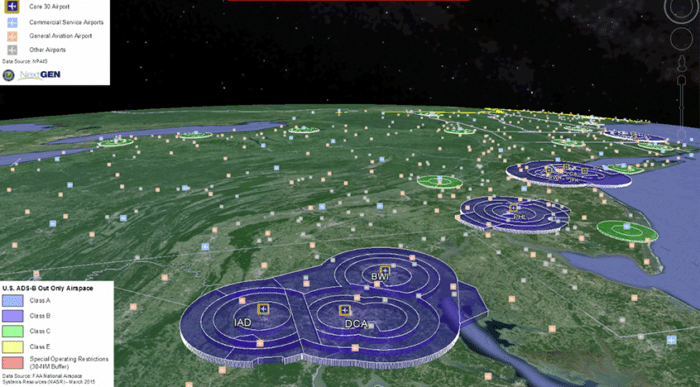
ADS-B airspace. (FAA)
The FAA has released its policy for dealing with non-compliant aircraft after the 2020 ADS-B mandate goes into effect: approve them, but only when convenient.
“Scheduled operators may request an authorization to deviate from ADS-B Out equipage requirements,” the FAA’s addition to the Federal Registry reads. “However … the rule requires an operator to make an authorization request at least [one] hour before each proposed operation to the ATC facility that has jurisdiction over the airspace.”
That doesn’t sound too onerous, but the request does not guarantee approval, according to the policy. Requests made by phone or during flight will not be granted, and approval is typically reserved for one-time or occasional use.
“While ATC will consider requests from scheduled operators, it is very unlikely to issue an authorization to a scheduled operator on more than an occasional basis,” the policy says.
Unscheduled operators — typically, part 135 and part 91 operators — will be particularly low on controllers’ list of priorities.
“It will be difficult for unscheduled operators conducting operations at capacity-constrained airports to obtain authorizations,” according to the policy.
Capacity-constrained airports — ones that operate at 85 percent capacity or greater — include BOS, CLT, ORD, DFW, ATL, JFK, LGA, LAX, LAS, PHL, DCA, SAN, SFO and SEA. “Unscheduled operators with a pressing or routine need to access ADS-B Out airspace near these airports should take the appropriate steps to equip before January 2020,” according to the policy, because “it is far more likely that the FAA will deny rather than issue authorization requests” for those locations.
The overarching message in the FAA’s amended policy is that non-equipped operators will be approved for flights only when controllers have time to do so, and their needs will be met last.
“ATC will make determinations as necessary to ensure equipped operators are not adversely impacted,” the policy says.
The agency is still encouraging operators to equip their aircraft. The policy states that FAA expects most traffic to be equipped, and an increasing amount as time goes on, although right now, a significant portion of the fleet is not scheduled to make the mandate. The benefits to ADS-B — from precise tracking to better search-and-rescue, to the ability to potentially lessen separation standards — manifest when everyone is equipped, and regulators have a vested interest in seeing that come to pass.
The new Federal Registry entry still notes that controllers will “continue to provide air traffic services to all aircraft operating within the airspace, including those that have not equipped,” but it is making clear where its priorities are.
The “per-operation authorizations were not intended to support routine and regular operations of non-equipped aircraft in ADS-B Out airspace,” the policy reads. “The FAA has not planned, nor does it plan to extend a significant amount of its limited budgetary resources to establish a new system to issue authorizations to the small number of operators of non-equipped aircraft.”